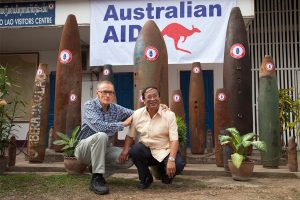The Australian government is reportedly preparing to bolster its aid programs in Southeast Asia, as concern in Canberra mounts about China’s growing influence in the region. According to an October 12 report in The Age, Australia is finalizing a Southeast Asian aid package that would inject of hundreds of millions of dollars into the region over the next four years.
The government of Prime Minister Scott Morrison has been accused of shortchanging Southeast Asia to pay for its recent $3 billion pledge to island nations in the Pacific, which Australia has long viewed as its strategic backyard. Admitting that Australia had often taken the Pacific island nations for granted, his “step-up in the Pacific” is designed to compete with China infrastructure-building spree in the region, under its Belt and Road Initiative.
The Age reports that the government is yet to decide on the final cost and scope of the Southeast Asian aid package, but that it will focus on the five nations of mainland Southeast Asia. In particular, it will include measures to ameliorate the impact of China’s cascade of 11 hydropower dams on the upper Mekong, which have been accused of exacerbating drought conditions downstream.
Beginning inside China, where it is known as the Lancang, the Mekong flows through Thailand, Myanmar, Laos, Cambodia and Vietnam, where it is central to the livelihoods of around tens of millions of people. Over the past year, the river has been hit by a severe drought, following on the heels of another record dry-spell in 2016.
By virtue of proximity, Australia has long been closely engaged with the nations of Southeast Asia, but recently its development budget to the region has been slashed. According to The Age, Australian aid to Southeast Asia has fallen by about $384.7 million, or 29.8 percent, over the past five years. Between the 2014-15 and 2019-20 financial years, aid to Vietnam dropped by $79.9 million. while assistance to the Philippines fell by $64.1 million, Cambodia by $32.7 million and Laos by $26.2 million.
As so often, the Australian shift comes in the wake a similar move by its American ally. Last month, the U.S. and the five downstream Mekong nations launched the Mekong-U.S. Partnership, a new framework for multilateral engagement that is designed to compete with China’s expansive Lancang-Mekong Cooperation mechanism. The announcement was accompanied by pledges of at least $153 million to help support disaster management, hydrological data-sharing and efforts to combat crossborder crime.
The U.S. and Australian moves follow the release in April of a report by Eyes on Earth, a U.S.-based research and consulting company, which argued that Chinese dams held back surplus rainfall in the first half of 2019, “even as downstream countries suffered through an unprecedented drought.” The Chinese government has challenged the report’s findings, while pledging to share more of its hydrological data with downstream nations.
The new aid package is a welcome augmentation of Australia’s engagement with the lower Mekong region, and with Southeast Asia as a whole. While Australia’s spending on defense has increased since 2013, its diplomatic budget has fallen to its lowest levels in history. In July, for instance, the Department of Foreign Affairs and Trade (DFAT) announced that it was cutting 60 positions, in addition to broad reductions to its operational budget. According to The Australian, some of the cut positions came from the Australian embassies in Beijing, Manila, Jakarta and Port Moresby.
While senior DFAT officials have spoken of the Indo-Pacific as “the key lens for Australian foreign policy,” in practice the commitment has mostly manifested as military spending. Shortly after news broke of the DFAT cuts, the Morrison government announced a $270 billion boost to Australia’s defense spending, driven by concern about China’s growing power and influence in its neighborhood and the need to prepare for a post-COVID-19 world that is “poorer, more dangerous and more disorderly.” As a result, Australia now spends just $1 billion per year on its diplomatic corps, compared to $28 billion per year on defense.
Over the long-term, Australia’s engagement with Southeast Asia is also likely to be undermined by the Liberal government’s recent reforms to Australia’s higher education sector. Driven largely by the Morrison government’s ideological animus toward the humanities and the social sciences, the changes will cut government support to universities and more than double fees for humanities degrees: the very fields that have nurtured generations of Australian scholars and specialists focusing on Southeast Asia.
The coming aid pledge is a welcome addition to Australia’s relationships in Southeast Asia, and a step toward the prioritization of the Indo-Pacific as a core arena of Australian foreign policy. But this falls short of a comprehensive, holistic strategy for engaging the region on Australia’s doorstep. As so often, Canberra’s actions remain at odds with its stated intentions.

































